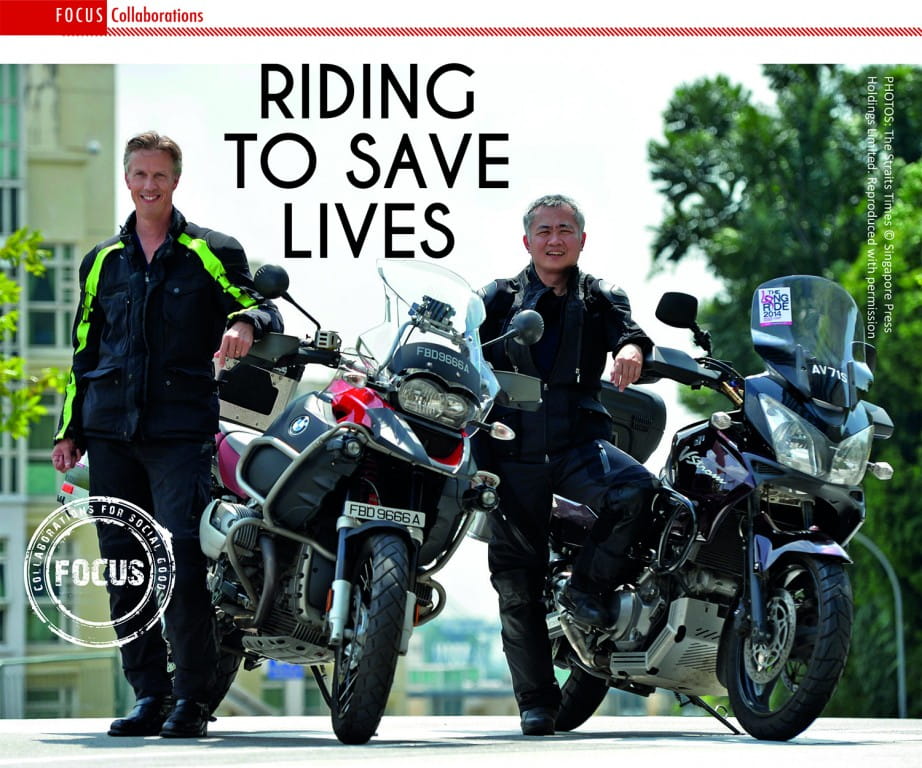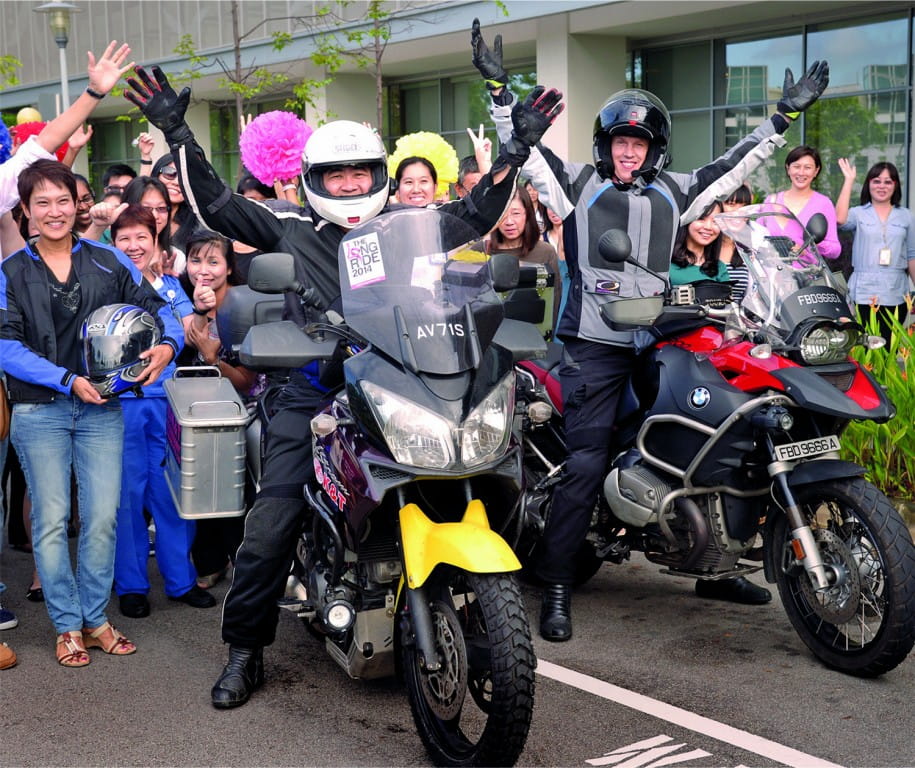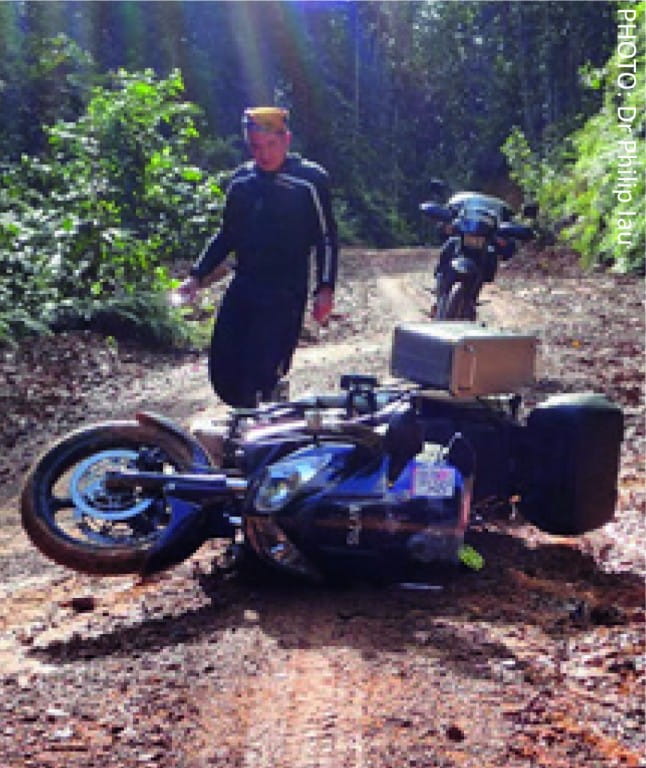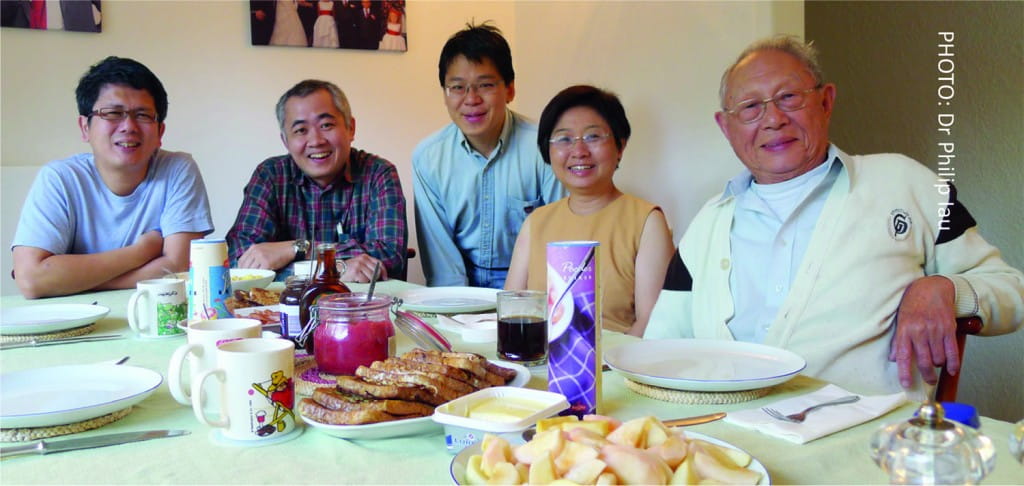
The Long Ride took Dr Mikael Hartman (left) and Dr Philip Iau (right) on a journey across 17 countries to raise awareness and funds for breast cancer research.
Two surgeons rode their motorbikes 23,000km from Singapore to Sweden in the name of breast cancer research. Their journey has resulted in friendships and collaborations with different medical institutions to help save the lives of women throughout Asia.
By Peter Buckenham
n March 2014, Clinical Associate Professor Philip Iau, 50, and Associate Professor Mikael Hartman, 48, put down their scalpels and took off on their motorbikes to go on a 23,000km journey from Singapore to Sweden to raise awareness of breast cancer. In 100 days, they crossed 17 countries and traversed both Asia and Europe, clocking up to 400km a day. They pit-stopped in Malaysia, Thailand, China, Turkey, Kazakhstan and Stockholm to conduct lectures, surgical demonstrations and public health symposiums.
The doctors are close friends, share a love of motorcycling and have adventurous spirits. Both work at the Department of Surgery, Yong Loo Lin School of Medicine at the National University of Singapore (NUS). In their work, they see the impact of breast cancer on the lives of women everyday and are determined to raise more awareness of the disease.
THE IDEA OF THE LONG RIDE
Dr Hartman had, for a long time, dreamt of riding a bicycle across the globe to his hometown in Stockholm, Sweden, and in 2012, he discussed his ambition with Dr Iau. “We realised if we tried to raise awareness and funds for breast cancer research, we could do this by the means of a long ride,” says Dr Iau.
The doctors expected resistance to their idea from their wives and their boss. But they received wholehearted support from their wives. Dr Iau said: “My wife, Viola, believed in what I was doing because her mother died of breast cancer. Then we needed approval for our leave. Not only did our boss, Prof Lee Chuen Neng, approve it, he even came along!”
Prof Lee led one of the support vehicles for half of the journey.
To prepare for their trip, the doctors started practising riding their motorbikes to Cameron Highlands in Malaysia two years before they embarked on their journey.
The doctors funded their trip themselves, which cost between S$15,000 and S$18,000 for accommodation, fuel and meals. In addition, they requested contributions towards the Breast Cancer Research Fund, which is administered by NUS and used for the research of Asian breast cancer issues. A fund-raising dinner held in August 2013 brought in nearly S$200,000 and together with the money raised through direct donations and a dollar-for-dollar contribution from the Singapore government, they collected close to S$3 million.
LEARNING FROM OVERSEAS COMMUNITIES
In urban areas such as Singapore, breast cancer numbers have doubled. A woman aged between 40 and 50 faces a 50% higher risk of contracting cancer as compared with a woman who is between 70 and 80 years. Before this, there has been no higher increase in other types of cancer, says Dr Iau.
Cancer figures in Beijing and many major cities in China are also equally high and seeing the high incidence rate in China was the “most sobering moment of the ride”.
“Early diagnosis is key to surviving breast cancer,” says Dr Hartman. Although routine check-ups are more effective than treatment or surgery, there was another challenge. He asks: “How do you tell women to come forward early? In a Western context, you just tell them to come for a check-up because Western women take charge of their own health care. But this concept is completely foreign in most of the places on our route.”
The doctors mapped their biking route to enable them to visit cancer centres and hospitals along the way, and meet staff and departments in China, Thailand and Malaysia through the Asian Hereditary Breast Cancer Group.
They also scheduled talks and clinic visits along the route. In Chiang Mai, Thailand, they did postgraduate teaching; in Kunming Province, China, they delivered a health symposium as well as postgraduate teaching at the Third People’s Affiliated Hospital; in Kazakhstan, they held a two-day cancer programme and did presentations in Utrecht, Copenhagen and Stockholm.
“We prepared ourselves for travelling for long distances and giving lectures. But what happened was that we learnt much more than we taught about breast cancer in Asia.”
— Dr Philip Iau, Clinical Associate Professor, National University of Singapore

Dr Iau (left) and Dr Hartman (right) together with their supporters at the start of their journey from Singapore.
On several occasions, the doctors were able to interact with patients. “In Lanzhou, Gansu Province, China, we interviewed a woman who lived in the rural area. It took her four days to travel to hospital and back. She needed chemotherapy twice a week for six months and also someone to take care of her home and children. Sometimes the barrier is not just cultural, but also physical,” says Dr Iau.
They even made friends in the most unlikely of places. During their trip, when refuelling at gas stations, they came across people who would open up when they found out what the doctors were doing. “They wanted to understand why cancer happened to someone they knew,” said Dr Iau. Encounters like these fuelled their need to find answers.
WARM HOSPITALITY
And despite the perils they encountered during their journey, they were lucky to meet locals who were ready to lend a helping hand. For example, the doctors experienced a dangerous sandstorm after crossing the border from China into Kazakhstan. The winds were strong enough to topple their motorbikes. Dr Hartman said: “We just couldn’t move.”

Dr Iau’s bike tumbled during a bike training session while riding through the jungle in Malaysia.
Fortunately, a Kazakhstani film crew, which was following the doctors and recording their journey for a television programme to be aired in Kazakhstan, guided the doctors to an impromptu shelter.
“It was a modest guesthouse with no beds, just benches and carpets where you can drink vodka and sleep but it was a fantastic relief,” says Prof Hartman. Dr Iau described the experience as “marvellous… our best night’s sleep ever.”
INTERVIEWS WITH CANCER PATIENTS
An ethnographic study (descriptive work resulting from participative and observational research) related to cultural understandings and behaviours of people with breast cancer is now being carried out in collaboration with the doctors’ professional and personal contacts from medical institutions in Kuala Lumpur and Penang in Malaysia, and in Kunming and Luzhou in China. Dr Iau’s former university mate, Associate Professor Cynthia Chou, who is now an anthropologist with the University of Copenhagen in Denmark, is leading a team in this study.
The study probes breast cancer from a cultural and social angle so that researchers can acquire a deeper understanding of the varied perceptions of breast cancer and cultural barriers that hinder effective diagnosis and treatment.
In the initial stages of the study, the doctors carried out group interviews in Malaysia and China with breast cancer patients and their caregivers to get a clearer picture of what life was like before and after the patients became ill, and their experience with treatment.
After the group interviews, Dr Chou’s anthropologists would take over and carry out a more in-depth study of
the patients.
“The deeper study might involve the anthropologists staying with the patients and their caregivers, if possible, to observe them,” explains Dr Iau.

Dr Phlip Iau, (second from left), having breakfast with former university mate Associate Prof Cynthia Chou, and her family in Copenhagen. Dr Iau and Prof Chou are now collaborating on a breast cancer research study.
In 2015, the study will expand to explore ways to change behaviours so that women will go for check-ups earlier. “That sounds easy but it’s not. Nudging people to change behaviour can take generations,” says Dr Hartman.
A BOOK AND A DOCUMENTARY
Dr Iau is currently writing a book about The Long Ride. Portions of his text can be found online at www.longridess.com. A 28-minute documentary of the doctors’ journey is also in production but details on when and where it will be aired have yet to be confirmed.
They are also deliberating the continuation of The Long Ride; Dr Iau is thinking of Africa whereas Dr Hartman, Indonesia.
Says Dr Hartman: “The door just creaked open, that’s all. There’s a lot of work we need to do to understand the cultural barriers. We can ask who is interested and who is keen to collaborate. We have to find health professionals that we can work with.”
Dr Iau sums up their experience of The Long Ride: “We prepared ourselves for travelling for long distances and giving lectures. But what happened was that we learnt much more than we taught about breast cancer in Asia. And we saw so many things that we didn’t expect to, like the stunning dawn at Cappadocia. My only regret is that the journey had to end.”
